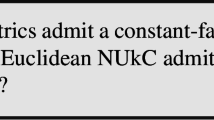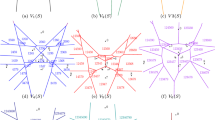Abstract
Given a finite set of points \(S\subset {\mathbb {R}}^d\), a k-set of S is a subset \(A\subset S\) of size k which can be strictly separated from \(S\setminus A\) by a hyperplane. Similarly, a k-facet of a point set S in general position is a subset \(\varDelta \subset S\) of size d such that the hyperplane spanned by \(\varDelta \) has k points from S on one side. For a probability distribution P on \({\mathbb {R}}^d\), we study \(E_P(k,n)\), the expected number of k-facets of a sample of n random points from P. When P is a distribution on \({\mathbb {R}}^2\) such that the measure of every line is 0, we show that \(E_P(k,n)=O(n(k+1)^{1/4})\). Our argument is based on a technique by Bárány and Steiger. We study how it may be possible to improve this bound using the continuous version of the polynomial partitioning theorem. This motivates a question concerning the points of intersection of an algebraic curve and the k-edge graph of a set of points. We also study a variation on the k-set problem for the set system whose set of ranges consists of all translations of some strictly convex body in the plane. The motivation is to show that the technique by Bárány and Steiger is tight for a natural family of set systems. For any such set system, we determine bounds for the expected number of k-sets which are tight up to logarithmic factors.
Similar content being viewed by others
Notes
Recall we assume that hyperplanes have measure 0. In all our results we also restrict to Borel measures. The Borel assumption guarantees that every open halfspace is measurable which is necessary for (1.1) (and, in particular, the definition of \(G_P(t)\)) to make sense. In fact the assumption that P is Borel is the minimal assumption that guarantees that all halfspaces are measurable because the collection of open halfspaces generates the Borel sigma algebra on \({\mathbb {R}}^d\).
[13, Lem. 9.10] states that the number of convex chains is \(k-1\) and the number of concave chains is \(n-k+1\). The reason this doesn’t match the Lemma as we have stated it is that [13] defines a k-edge to be line segment connecting two points x, y such that there are k points in the closed halfspace below \({\text {aff}}(x,y)\) whereas we require that there are k points in the open halfspace below \({\text {aff}}(x,y)\). We choose open because it matches the standard definition of a k-facet.
We use the following version of the law of total probability: \({\mathbb {P}}(A\,|\,Y) ={\mathbb {E}}({\mathbb {P}}(A\,|\,X,Y)\,|\,Y)\). This follows from [7, Thm. 4.1.13 (ii)].
When \(k=({n-2})/{2}\) this counts each k-edge twice, so the constant in our bound can be improved in this case.
One could consider the same question for possibly singular curves, but, for our purposes, it suffices to consider non-singular curves.
The proof of Theorem 3.5 relies on the Stone–Tukey ham sandwich theorem [25] for \(L^1\) functions on \({\mathbb {R}}^d\). There is a version of the ham sandwich theorem which applies to more general distributions but it has a weaker conclusion and cannot be used to extend Theorem 3.5 to more general distributions as far as the authors know.
In order to apply VC’s uniform convergence theorem, we need to verify that the function \(\sup _{R\in {\mathcal {R}}}(\,{\cdot }\,)\) as defined in (4.1) is measurable, i.e., that it is a random variable. This can be verified by observing that \(\mathcal {R}\) is a permissible class of subsets of A. See [22, Appendix C] for the definition of permissible classes and a proof of the measurability of suprema in this context. One can see that the class \({\mathcal {R}}\) is permissible by indexing it by translation and verifying that the requirements for permissibility are met.
References
Agarwal, P.K., Aronov, B., Chan, T.M., Sharir, M.: On levels in arrangements of lines, segments, planes, and triangles. Discrete Comput. Geom. 19(3), 315–331 (1998)
Bárány, I., Steiger, W.: On the expected number of \(k\)-sets. Discrete Comput. Geom. 11(3), 243–263 (1994)
Chiu, M.-K., Felsner, S., Scheucher, M., Schnider, P., Steiner, R., Valtr, P.: On the average complexity of the \(k\)-level. J. Comput. Geom. 11(1), 493–506 (2020)
Clarkson, K.L.: On the expected number of \(k\)-sets of coordinate-wise independent points (2004). https://kenclarkson.org/cwi_ksets/p.pdf
Dey, T.K.: Improved bounds on planar \(k\)-sets and \(k\)-levels. In: 38th Annual Symposium on Foundations of Computer Science (Miami Beach 1997), pp. 156–161. IEEE, Los Alamitos (1997)
Dey, T.K.: Improved bounds for planar \(k\)-sets and related problems. Discrete Comput. Geom. 19(3), 373–382 (1998)
Durrett, R.: Probability—Theory and Examples. Cambridge Series in Statistical and Probabilistic Mathematics, vol. 49. Cambridge University Press, Cambridge (2019)
Erdős, P., Lovász, L., Simmons, A., Straus, E.G.: Dissection graphs of planar point sets. In: A Survey of Combinatorial Theory (Fort Collins 1971), pp. 139–149. North-Holland, Amsterdam (1973)
Gruber, P.M.: Convex and Discrete Geometry. Grundlehren der mathematischen Wissenschaften, vol. 336. Springer, Berlin (2007)
Guth, L.: Polynomial Methods in Combinatorics. University Lecture Series, vol. 64. American Mathematical Society, Providence (2016)
Guth, L.: A restriction estimate using polynomial partitioning. J. Am. Math. Soc. 29(2), 371–413 (2016)
Guth, L., Katz, N.H.: On the Erdős distinct distances problem in the plane. Ann. Math. 181(1), 155–190 (2015)
Har-Peled, S.: Geometric Approximation Algorithms. Mathematical Surveys and Monographs, vol. 173. American Mathematical Society, Providence (2011)
Hummel, P.M.: A note on Stirling’s formula. Am. Math. Mon. 47(2), 97–99 (1940)
Kaplan, H., Matoušek, J., Sharir, M.: Simple proofs of classical theorems in discrete geometry via the Guth–Katz polynomial partitioning technique. Discrete Comput. Geom. 48(3), 499–517 (2012)
Kirwan, F.: Complex Algebraic Curves. London Mathematical Society Student Texts, vol. 23. Cambridge University Press, Cambridge (1992)
Lovász, L.: On the number of halving lines. Ann. Univ. Sci. Budapest. Eötvös Sect. Math. 14, 107–108 (1971)
Matoušek, J.: Lectures on Discrete Geometry. Graduate Texts in Mathematics, vol. 212. Springer, New York (2002)
Milnor, J.: On the Betti numbers of real varieties. Proc. Am. Math. Soc. 15, 275–280 (1964)
Naszódi, M., Taschuk, S.: On the transversal number and VC-dimension of families of positive homothets of a convex body. Discrete Math. 310(1), 77–82 (2010)
Nivasch, G.: An improved, simple construction of many halving edges. In: Surveys on Discrete and Computational Geometry (Snowbird 2006). Contemp. Math., vol. 453, pp. 299–305. American Mathematical Society, Providence (2008)
Pollard, D.: Convergence of Stochastic Processes. Springer Series in Statistics. Springer, New York (1984)
Rutter, J.W.: Geometry of Curves. Chapman & Hall/CRC, Boca Raton (2000)
Sheffer, A.: Polynomial Methods and Incidence Theory. Book draft (2020). http://faculty.baruch.cuny.edu/ASheffer/000book.pdf
Stone, A.H., Tukey, J.W.: Generalized “sandwich’’ theorems. Duke Math. J. 9, 356–359 (1942)
Tóth, G.: Point sets with many \(k\)-sets. In: 16th Annual Symposium on Computational Geometry (Hong Kong 2000), pp. 37–42. ACM, New York (2000)
Tóth, G.: Point sets with many \(k\)-sets. Discrete Comput. Geom. 26(2), 187–194 (2001)
Vapnik, V.N., Chervonenkis, A.Ya.: On the uniform convergence of relative frequencies of events to their probabilities. Theor. Probab. Appl. 16(2), 264–280 (1971)
Wagner, U.: \(k\)-sets and \(k\)-facets. In: Surveys on Discrete and Computational Geometry (Snowbird 2006). Contemp. Math., vol. 453, pp. 443–513. American Mathematical Society, Providence (2008)
Acknowledgements
We would like to thank the reviewers for their helpful suggestions. In particular, we are grateful to the anonymous reviewer who noticed that the bound in Theorem 1.3 could be significantly improved with a simple modification to the proof. This material is based upon work supported by the National Science Foundation under Grant Nos. CCF-2006994, CCF-1657939, CCF-1422830, and CCF-1934568.
Author information
Authors and Affiliations
Corresponding author
Additional information
Editor in Charge: Kenneth Clarkson
Publisher's Note
Springer Nature remains neutral with regard to jurisdictional claims in published maps and institutional affiliations.
Rights and permissions
Springer Nature or its licensor (e.g. a society or other partner) holds exclusive rights to this article under a publishing agreement with the author(s) or other rightsholder(s); author self-archiving of the accepted manuscript version of this article is solely governed by the terms of such publishing agreement and applicable law.
About this article
Cite this article
Leroux, B., Rademacher, L. Improved Bounds for the Expected Number of k-Sets. Discrete Comput Geom 70, 790–815 (2023). https://doi.org/10.1007/s00454-022-00469-7
Received:
Revised:
Accepted:
Published:
Issue Date:
DOI: https://doi.org/10.1007/s00454-022-00469-7




